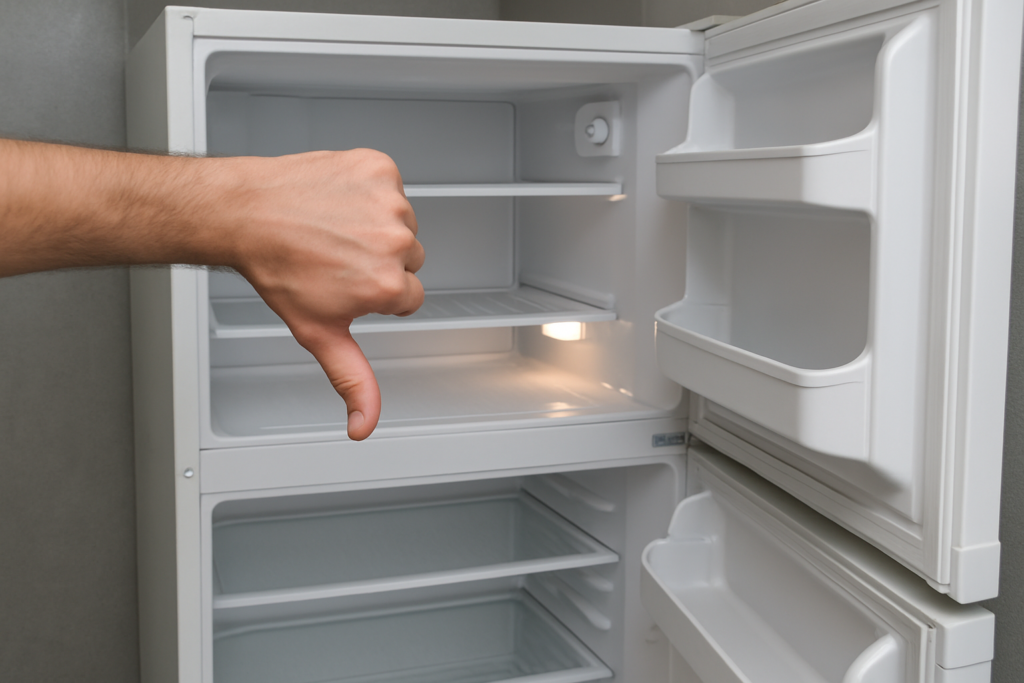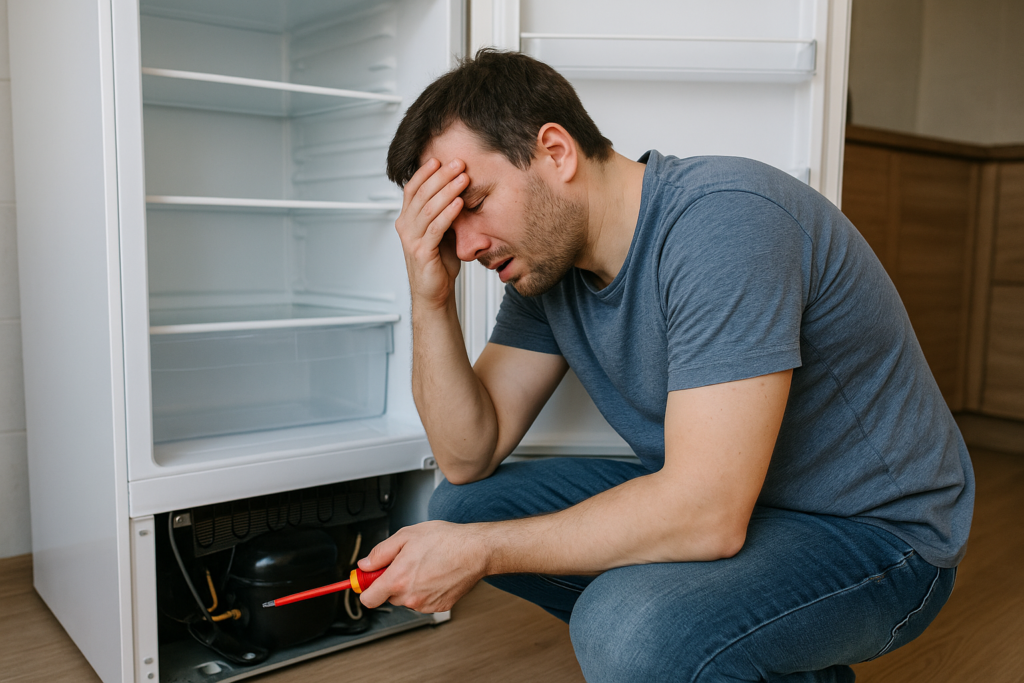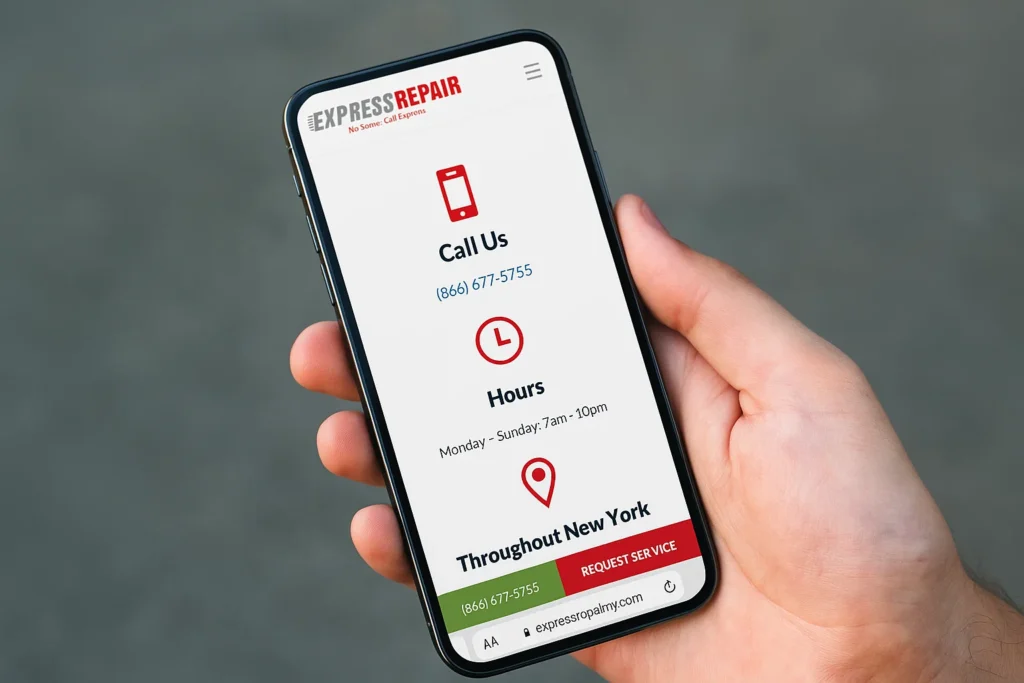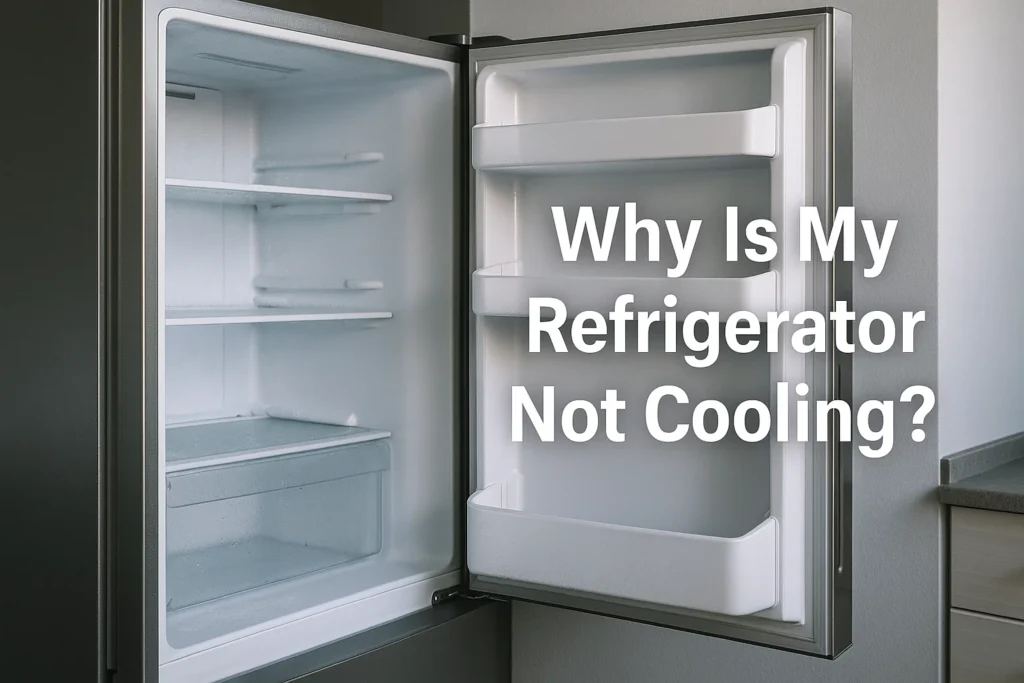Opening your fridge and finding warm drinks or spoiled food is one of the most frustrating household problems. A refrigerator not cooling is more than an inconvenience — it can mean wasted groceries, unexpected expenses, and even potential health risks.
The good news: not every cooling issue requires a costly repair. In many cases, you can troubleshoot and fix the problem yourself. In this guide, we’ll break down the most common reasons why your refrigerator is not cooling, share practical DIY solutions, and explain when it’s time to call in a professional.

Common Reasons Your Refrigerator Is Not Cooling
1. Power Supply Issues
Sometimes the problem is as simple as the fridge not getting electricity.
What to do:
- Make sure the power cord is securely plugged into the outlet.
- Inspect the cord for visible damage.
- Check your circuit breaker or fuse box.
- Plug another device into the same outlet to confirm it works.
2. Incorrect Temperature Settings
Accidentally changing the settings can stop the fridge from cooling properly.
What to do:
- Check the control panel.
- The refrigerator should be set between 37–40°F (3–5 °C).
- The freezer should be at 0°F (–18 °C).
- After adjusting, wait a few hours to see if the temperature stabilizes
3. Blocked Vents and Poor Air Circulation
If the refrigerator is packed too tightly, cold air cannot circulate.
What to do:
- Keep some space between items and the walls.
- Avoid putting hot food directly inside.
- Make sure vents inside the fridge are not blocked.
4. Dirty Condenser Coils
Dusty or greasy coils make it harder for the fridge to cool.
What to do:
- Unplug the refrigerator.
- Locate the coils (usually at the back or bottom).
- Clean them with a vacuum and brush.
- Do this at least once or twice a year.
5. Faulty Evaporator Fan
The evaporator fan circulates cold air. If it fails, cooling stops.
What to do:
- Unplug the fridge and check the fan.
- Remove ice buildup or debris around the blades.
- If the fan doesn’t run even after cleaning, it likely needs replacement.
6. Defective Thermostat or Control Board
When the thermostat or main board fails, the cooling cycle won’t start.
What to do:
- Turn the thermostat dial—if you don’t hear a click, it may be faulty.
- If the fridge still doesn’t cool, the control board may be defective.
- These repairs usually require a professional technician.
Quick Checks You Can Do Yourself
Before you call a repair service, there are a few quick things you can try on your own. First, make sure the refrigerator is actually getting power—sometimes the issue is as simple as a loose plug or a tripped breaker. If the outlet works, take a moment to check the temperature settings, since they can be accidentally changed and prevent proper cooling. Another easy fix is cleaning the condenser coils with a vacuum or brush, because dust and dirt can make the fridge run inefficiently. You should also look at how food is arranged inside; overcrowded shelves or blocked vents can stop cold air from circulating evenly. Finally, examine the door seals to ensure they are closing tightly. If they’re dirty or worn out, cold air can escape, making the refrigerator work harder than it should.

When a Simple Reset Helps
Sometimes your refrigerator just needs a quick reboot. Unplugging the appliance for 10–15 minutes and then plugging it back in works like a soft reset for the system. This simple step can clear minor electronic glitches, reset the control board, and help the cooling cycle start again. In many cases, homeowners are surprised to find that after a short reset, the fridge begins cooling normally. It’s especially useful if your refrigerator has been running continuously without a break or if there was a recent power surge. While this trick won’t solve deeper mechanical problems, it’s worth trying before moving on to more complex troubleshooting.
Problems You Shouldn’t Try to Fix Yourself
While basic maintenance and checks can often restore proper cooling, some refrigerator issues should always be left to professionals. If the problem lies in a broken compressor, a refrigerant leak, or a defective control board, these are not DIY jobs. Compressors require special tools and knowledge to replace, refrigerant leaks involve handling chemicals that can be dangerous, and control board repairs demand expertise in electrical components. Attempting these fixes without proper training can lead to further damage, higher repair costs, or even safety risks. If your fridge still isn’t cooling after trying the basic steps, calling a qualified technician is the safest and most effective solution.
Time to Call a Professional
Even after cleaning coils and adjusting settings, your refrigerator may still refuse to cool. Here are clear signs you need expert help:
-
- The fridge makes loud clicking or buzzing sounds.
- The freezer is cold, but the fridge is warm.
- You notice puddles of water or frost buildup inside.
- The compressor runs constantly but the temperature doesn’t drop.

Signs of a Broken Compressor
A failing compressor often makes unusual clicking or buzzing noises as it tries to start but cannot keep running. In some cases, the refrigerator may hum for a few seconds and then shut off repeatedly. Another clear sign is when the fridge is warm inside while the motor feels extremely hot to the touch. If the compressor doesn’t run at all, the refrigerator won’t cool no matter how long it’s plugged in.
Signs of a Refrigerant Leak
When refrigerant is leaking, the cooling efficiency drops noticeably. You may find that the fridge runs constantly but never reaches the proper temperature. Sometimes, frost builds up on the evaporator coils or you might notice an oily residue near the tubing, which is a common indicator of a leak. A refrigerant issue usually causes both the refrigerator and freezer sections to feel warmer than normal.
Signs of a Faulty Control Board
A defective control board often leads to inconsistent performance. The fridge may cool one day and fail the next, or it might not respond to temperature adjustments at all. In some cases, lights, fans, or the compressor won’t turn on because the board isn’t sending the correct signals. If the display panel glitches, resets randomly, or shows error codes, this is another strong sign that the control board is failing.
If any of these sound familiar, it’s likely not a DIY fix.
Refrigerator Not Cooling? Get Expert Help
When troubleshooting doesn’t solve the problem, don’t wait too long — spoiled food and wasted energy can cost more than a repair visit.
For fast, reliable service, check our fridge repair. Our certified technicians will diagnose the issue, repair your refrigerator, and get your kitchen back to normal quickly.
Whether it’s a simple fix or a major repair, we’ll make sure your fridge is cooling properly again.

